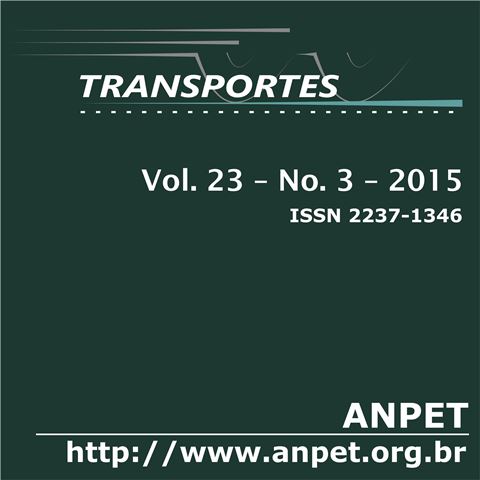...
DOI:
https://doi.org/10.14295/transportes.v23i3.936Keywords:
Highways, HCM, Volume-Delay FunctionsAbstract
This paper identified in the literature and described the most commonly used delay functions in transportation demand modeling packages: (1) BPR; (2) Conical; (3) Akçelik function; and (4) Logit-Based. Then it was tested the compatibility between these four VDFs and the current HCM models, calibrated to Brazilian highways. As the main conclusions, it was observed that the best fits were obtained using the BPR and the Logit-Based Functions. On the other hand, the Conical and Akçelik functions should be used with caution, since they tend to underestimate the delay for low to moderate traffic flows, common in rural highways. Specifically with respect to two-lane highways, the Logit-Based function has proved to be of interest, because of its capability to reflect more severe delays for low traffic flows, while producing greater delays for congested conditions, which is a desirable characteristic in demand modeling.Downloads
References
Akçelik, R. (2003) Speed-Flow Models for Uninterrupted Traffic Facilities. Akçelik & Associates Pty Ltd, 34 p.
Andrade, G. R.; Rodrigues-Silva, K. C.; Puty Filho, S. A. (2011) Panorama Normativo e Tecnológico da Avaliação Operacional das Concessões Rodoviárias. In: Anais do 7° Congresso Brasileiro de Rodovias e Concessões – CBR&C 2011, Foz do Iguaçu, PR (CD-ROM), 14 p.
Andrade, G. R.; Setti, J. R. (2014) Speed-Flow Relationship and Capacity for Expressways in Brazil. Transportation Research Circular, v. E-C190, p. 10–25. ISSN 0097-8515. Disponível em: <http://sites.poli.usp.br/d/ptr2377/14-1707setti.pdf>
Bessa Jr., J. E.; Setti, J. R. (2011) Derivation of ATS and PTSF Functions for Two-lane, Rural Highways in Brazil. In: 6th International Symposium on Highway Capacity and Quality of Service, 2011, Stockholm. Procedia: Social and Behavioural Sciences. Amsterdam: Elsevier, v. 16. p. 282-292. Doi:10.1016/j.sbspro.2011.04.450.
BPR (1964) Traffic Assignment Manual. U.S. Department of Commerce, Urban Planning division, Washington, D.C., EUA.
Caliper (2013) Travel Demand Modeling with TransCAD Version 6.0 User’s Guide. Caliper Corporation, EUA, 602 p.
HRB (1965) Highway Capacity Manual. Highway Research Board, Washington, D.C., EUA.
Huntsinger, L. F.; Rouphail, N. M. (2011) Bottleneck and Queuing Analysis. Transportation Research Record, v. 2255, p. 117-124. Doi: http://dx.doi.org/10.3141/2255-13.
Kurth, D. L.; van den Hout, A.; Ives, B. (1996) Implementation of “Highway Capacity Manual”-Based Volume–Delay Functions in Regional Traffic Assignment Process. Transportation Research Record, v. 1556, p. 27–36.
Doi: http://dx.doi.org/10.3141/1556-05.
Machado, O. F.; Ribeiro, P. C. M. (2003) Calibração da Função de Capacidade do BPR para uma Via Expressa Brasileira. In: Anais do I Rio de Transportes, I Congresso de Ensino e Pesquisa do Estado do Rio de Janeiro, Rio de Janeiro, v. 1, p. 1-12.
Setti, J. R. (2009) Highway Capacity Manual ou Manual de Capacidade Viária? Anais do 6° Congresso Brasileiro de Rodovias e Concessões – CBR&C 2009, Florianópolis, SC.
Setti, J. R.; Bessa Jr., J. E.; Egami, C. Y.; Mon-Ma, M. L. (2011) Adaptação do HCM2000 para análise da capacidade e do nível de serviço em rodovias de pista simples no Brasil. Transportes, v. 19, p. 66-78.
Doi: http://dx.doi.org/10.14295/transportes.v19i2.510.
Singh, R.; Dowling, R. (2002) Improved Speed–Flow Relationships: Application to Transportation Planning Models. In: Proc. 7th TRB Conference on the Application of Transportation Planning Methods, TRB, National Research Council, Washington, D.C., p. 340–349.
Spiess, H. (1990) Conical Volume-Delay Functions. Transportation Science, v. 24, n. 2, p. 153-158.
Doi: http://dx.doi.org/10.1287/trsc.24.2.153.
TRB (1994) Highway Capacity Manual. Special Report 209 (1994 update). Transportation Research Board, Washington, D.C.
TRB (2000) Highway Capacity Manual 2000. Transportation Research Board, Washington, D.C.
TRB (2010) Highway Capacity Manual 2010. Transportation Research Board, Washington, D.C.
Downloads
Published
How to Cite
Issue
Section
License
Authors who submit papers for publication by TRANSPORTES agree to the following terms:
- The authors retain the copyright and grant Transportes the right of first publication of the manuscript, without any financial charge, and waive any other remuneration for its publication by ANPET.
- Upon publication by Transportes, the manuscript is automatically licensed under the Creative Commons License CC BY 4.0 license. This license permits the work to be shared with proper attribution to the authors and its original publication in this journal.
- Authors are authorized to enter into additional separate contracts for the non-exclusive distribution of the version of the manuscript published in this journal (e.g., publishing in an institutional repository or as a book chapter), with recognition of the initial publication in this journal, provided that such a contract does not imply an endorsement of the content of the manuscript or the new medium by ANPET.
- Authors are permitted and encouraged to publish and distribute their work online (e.g., in institutional repositories or on their personal websites) after the editorial process is complete. As Transportes provides open access to all published issues, authors are encouraged to use links to the DOI of their article in these cases.
- Authors guarantee that they have obtained the necessary authorization from their employers for the transfer of rights under this agreement, if these employers hold any copyright over the manuscript. Additionally, authors assume all responsibility for any copyright infringements by these employers, releasing ANPET and Transportes from any responsibility in this regard.
- Authors assume full responsibility for the content of the manuscript, including the necessary and appropriate authorizations for the disclosure of collected data and obtained results, releasing ANPET and Transportes from any responsibility in this regard.









